High School Students Learn From and Educate Communities About Hudson River Ecosystems
In the Next Generation of Hudson River Educators program, students learned what community members think about the Hudson and developed tools to share their own findings.
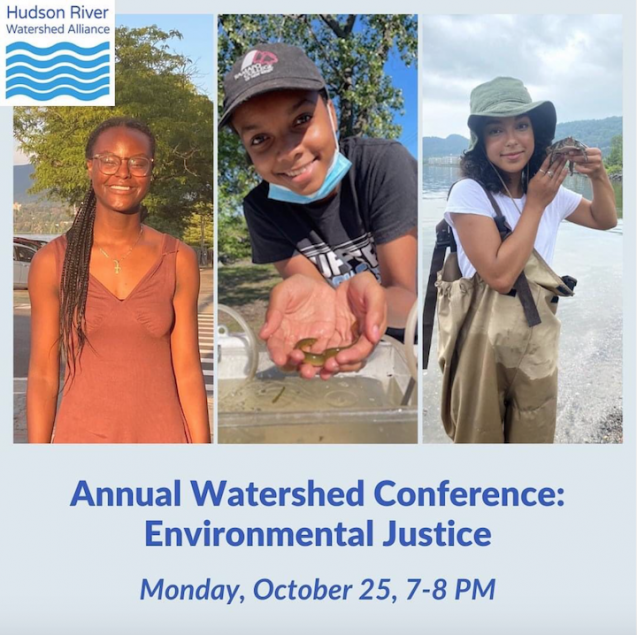
One of the central tenets of Next Gen is the focus on two way communication. This includes not only reaching out to community members to listen to their perspectives, but also coming back to share our findings and observations with that community. Too often this circling back to the community is overlooked. All of our summer participants were able to do so, however, through a series of meetings that included presenting their findings and providing recommendations to the Piermont and Haverstraw Village Boards, and presenting to local planning and community groups. Most recently, several of the students participated at the Hudson Valley Watershed Alliance annual conference as part of a panel of youth selected for their roles in creating regional change.
Below, we share some of the products created by our student interns as they developed their science communication skills and spread their newfound knowledge about the Hudson, debunking several long-standing myths and misunderstandings along the way. From using social media to creating unique games, the students created a range of educational outputs to educate the culturally, ethnically, and racially diverse communities along the Hudson River.
The Role of Social Media in Today’s Communications
by Jiaming Li, student at Tenafly High School
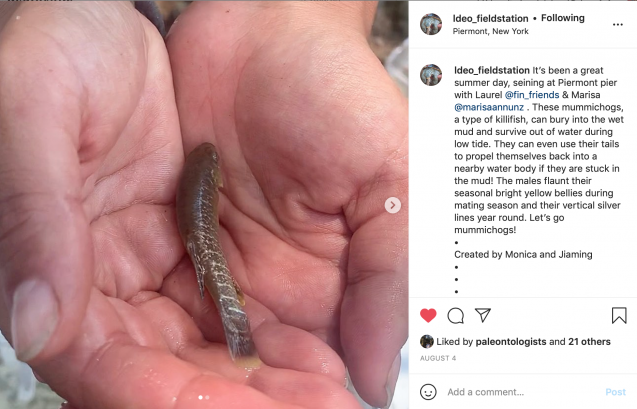
Social media is the first thing many of us turn to when we wake up in the morning. It is used by multiple generations for communication, entertainment, and education. Because of social media’s ability to target multiple demographics, Lamont’s Next Gen participants decided to make Instagram posts, TikToks, and YouTube videos to share our findings about the Hudson River with the public. We recognize the importance of educating others about the information we have been uncovering about the Hudson. While most people don’t regularly read scientific journals, many do visit social media daily. Using social media as a platform is a great opportunity to share scientific information that is not only comprehensible, but also digestible. It’s also a great way to share fun facts with people who are curious about their local environment.
We conducted interviews with friends, neighbors, and members of the Hudson community to uncover any misconceptions about the river. Our findings indicated that older generations tend to have a greater appreciation for the Hudson, while younger interviewees tend to have more misconceptions that have been passed along through the grapevine. This suggested that social media is the perfect outlet to target younger demographics and educate them about this mighty river.
Many of us documented our fun seining experiences and shared the species of fish and crabs we caught in the Hudson via social media. Some of us made day-in-the-life vlogs (video blogs), while others created MythBusters parodies to share the information we learned. We all enjoyed filming each other and editing our videos and learned a lot about communication as we tried to make short targeted posts. Sharing the knowledge we gained with our communities was incredibly fulfilling and important. Creating social media content was an amazing way for us to bond with each other because we completed all of our social media projects in groups or pairs. I had an amazing experience working on projects with my partner Monica, and we both developed a fascination with the mummichog, a small marsh loving type of killifish native to the Hudson, which is also known as a mud minnow because it buries itself into the mud during low tide when there is little water.
Find out more about seining, mummichogs and other aspects of the Hudson River at @ldeo_fieldstation on Instagram and Lamont-Doherty Earth Observatory on YouTube.
Myth Busting the Lower Hudson Estuary
by Monica Rivera, student at Tappan Zee High School
When the Next Gen educators interviewed members of the Rockland community to find out their perspectives and knowledge of the Lower Hudson Estuary, we learned that the river’s reputation misaligns with scientific facts. A majority of interviewees believe that the river is dirty due to what they see as the color of the water. Truthfully, the color of the water is due to high turbidity. Turbidity is the amount of cloudiness or opacity of the water. In the Lower Estuary, it is caused by rich nutrients, phytoplankton (photosynthesizing microscopic organisms) and algae, runoff after a rainstorm, and the movement of loose sediments due to tides, currents, wind, and turbulent mixing from the density differences between the fresh and saltwater.
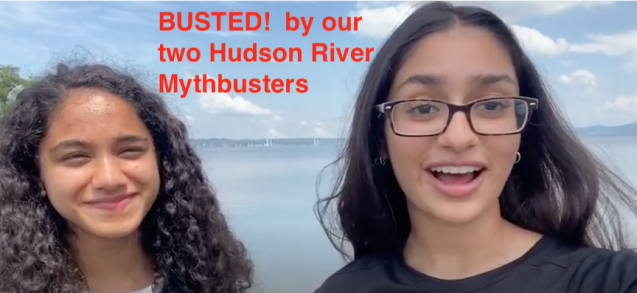
Other common misconceptions are in regards to life in the Hudson. Many people believe that the Hudson is a lifeless water body. This is certainly not true. But many forms of life do bear the remnants of decades of prior pollution, which can be dangerous. Some Hudson fishermen believe that the fish of the lower estuary are safe to eat, yet most of the fish in the tidal Hudson should not be eaten, while some can only be eaten once a month. Age also plays a factor. Women below the age of 50 are encouraged to not eat any of the fish from the tidal Hudson, but men over the age of 15 can eat some fish that are designated as safe for consumption. Why do these restrictions exist? A large number of the fish are contaminated with chemicals, such as PCBs, that are unsafe to humans. PCB, which stands for polychlorinated biphenyl, is a human made chemical used as a lubricant and a coolant for machinery by many industries along the Hudson River. General Electric, a company located in the Upper Hudson was a major contributor, dumping PCBs for about 30 years into the Hudson and contaminating the water for years to come. Luckily, the Environmental Protection Agency found GE liable for their contamination and required them to conduct a 6 year clean up in the Upper Hudson of some PCB hotspots. This ended in 2015. Though the Hudson is much cleaner and safer than it was 20 years ago, the fish are still greatly affected by the persistent levels of PCBs that continue to circulate and settle at the bottom of the river. Despite the residual PCBs, the Hudson River is safe to interact with and it is even swimmable in many sections.
The Value of Field Sampling
by Janice Yohannan, student at Nyack High School
Over the summer, I found that the most incredible part of Lamont’s Next Gen program was being in the field two days a week. This allowed for hours of exciting field exploration and data collection. We were able to conduct soil and water chemistry tests, take sediment cores, and conduct habitat assessments to help better understand the environmental conditions in Piermont and Haverstraw as well as their implications for the ecosystem. We also learned to test soil for lead and measure turbidity, tides, and currents. We created step by step protocols to help others who want to do this type of sampling.
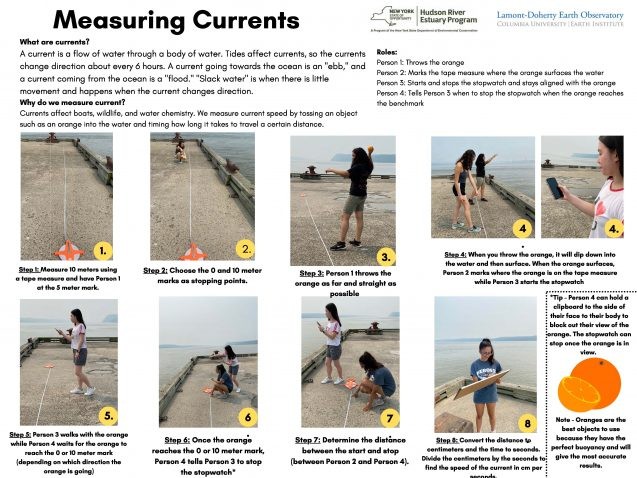
Our team often discussed the importance of conducting all these tests and experiments. In reality, there are so many factors that are involved when it comes to assessing the health of an ecosystem and understanding how different parts of this ecosystem work together. For example, we tested for levels of dissolved oxygen in the water, a measurement of the amount of oxygen available in the water for use by aquatic organisms. Since dissolved oxygen is necessary for the survival of aquatic life, monitoring it is essential in determining the health of the river’s ecosystem.
However, my favorite field activity was, hands-down, seining (shown in this Instagram post by Talha Uddin and Arianna Smith). Putting on waders and getting waist deep in water, trying your best not to fall in the river, and feeling the currents press the water all around you, is unlike anything I’ve experienced. I cannot think of a better way to connect with the river and with my local environment as a whole. Seining is also a super fun way to realize that the Hudson is full of life! From blue crabs to American eels to mummichogs (the small, marsh-loving killifish shown above in Jiaming’s section), we’ve caught and released beautiful animals. You can also view this short video made by Jiaming Li and Monica Rivera on the wildlife in the Hudson. Being a part of these incredible field experiences has greatly influenced my passion for environmental stewardship, and I am more excited than ever to protect my local environment!
Communicating Science Through Games
by Arianna Smith, student at Suffern High School
Games are a great way to bring people together, have fun, and be competitive, while also effectively educating others. The games created by the interns from Lamont-Doherty’s Next Generation of Hudson River Educators are the perfect combination of fun and information. For the past few weeks, we have been working on data games where our goal is to educate the public on a particular Hudson River topic. We utilized data from the Tuva Interactive Data Site and the Day in the Life of the Hudson and Harbor Database to create games that teach foundational Hudson science. The Haverstraw and Piermont groups collaborated together to create unique games that will be shared with the general public, and, hopefully, educate them about our thriving river ecosystem.
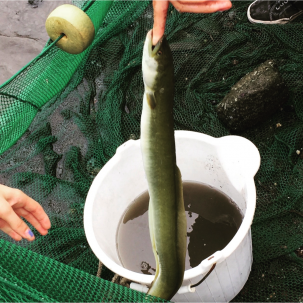
My partner Monica and I came up with a data game revolving around polychlorinated biphenyls (PCBs) and fishing in the Hudson. PCBs are human made chemicals used widely in electrical equipment like capacitors and transformers. Starting in the 1940s and continuing until the ban on PCBs in the 1970s, General Electric and other companies dumped these chemicals into the river. Although many efforts have been made to clean the Hudson of PCBs, they still have an effect on the fish and wildlife in the river with certain fish accumulating more PCBs than others. Our game is called “Fishing Frenzy, ” where you are fishing the Hudson River using toy fishing rods to catch as many fish as possible in a given amount of time. Once the time runs out players have to release fish with high levels of PCBs, and whoever has the most fish left wins!
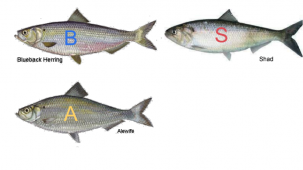
Our other friends created their own unique games as well. Jiaming and Talha created the game “Survival of the Herring” where you play as three different herring species and have to make it to the end of the board game; Janice and Sarah-Gail’s “Guess Who” Hudson River species game has players identify their Hudson species by guessing characteristics about them; Kaitlyn and Shania created a decision making game about water chestnuts and a data Jeopardy game!
Creating the game was a bit tricky as my partner and I had so many ideas that we wanted to incorporate. We had to go through each scenario of the game in our minds to predict the outcome and ensure it would conclude smoothly. This portion of our game making process was filled with many obstacles, but in the end we were able to create a fun, easy to understand game that educates people about the Hudson for people of all ages to enjoy.
Creating a game was one of my favorite parts of the program as I was able to take all the ideas stirring in my mind and bring them to life. Gathering feedback through ideas and suggestions from our peers and mentors was very helpful, and they played a big role in the development of our game. It was such a unique experience, and I hope the people playing these games have as much fun as we did making them!
Conclusion
The educational outputs that were created by the students are comprehensive and designed for all ages.They are showcased on Lamont-Doherty Earth Observatory Field Station’s Instagram (@ldeo_fieldstation), Hudson River Field Station’s website, and were placed on display at the Rockland Conservation and Service Corps’ science fair event. Attending decision makers and community members were shocked to learn that the creators of our educational output materials were high school interns. The members stepped away more informed and with a greater appreciation for the Hudson River. Our interns have left this program with life changing field experiences and valuable scientific communication skills.
—Introduction and conclusion written by Marisa Annunziato, undergraduate near peer mentor from Rockland Conservation & Service Corps.
See other blogs from the 2021 Next Gen Program “Issues of Inequity Explored by the Next Generation of Hudson River Educators” and “Personal Interviews Gain Insights to Community Perspectives”.
Funders: Lamont’s Next Generation of Hudson River Educators Program is a program funded through a grant from the NYS DEC, with support from Old York Foundation, the Henry L. and Grace Doherty Charitable Foundation, Inc. and additional student support from the NSF INCLUDES program. For six weeks this summer the program ran a hybrid format with 2 field days (with teams in both Piermont and Haverstraw NY) and 3 virtual days each week. Eight high school students joined two Rockland Conservation Corps members and Lamont’s Laurel Zaima and Margie Turrin for an in depth experience.
